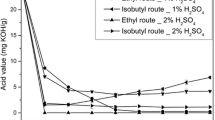Abstract
Our previous isolation of branched-chain fatty acid (BCFA) methyl esters from lanolin was improved and scaled up. Also, oleate esters of isopropanol, oleyl alcohol and normal alcohols of 1–12 carbons chain lengths were prepared. Esters were made by interesterification with sodium alcoholates and by esterification with Candida antarctica lipase. It proved easier to obtain pure esters by the enzymatic synthesis. Melting points and viscosities over the range of 0–70 °C were determined in order to better identify potential lubricant targets that might be produced by genetically modified oilseed crops. Isopropyl and butyl oleate have melting points of −33 and −32 °C, respectively and viscosities that range from ~17 cp (0 °C) to ~2.5 cp (70 °C). They should have suitable stability for lubricants. BCFA esters had viscosities similar to their straight chain analogs. Viscosities increased with alcohol chain length and decreased with temperature. The dependence of viscosity on temperature was fit with an equation based on Erying’s rate equation. Some esters with branched acid or branched alcohol moieties, and some oleate esters might be utilized as biolubricants or biofuels on the basis of their melting points and viscosities.


Similar content being viewed by others
References
Yao L, Hammond EG (2006) Isolation and melting properties of branched fatty esters from Lanolin. J Am Oil Chem Soc 83:547–552
Fatemi SH, Hammond EG (1980) Analysis of oleate, linoleate and linoleate hydroperoxides in oxidized ester mixtures. Lipids 15:379–385
Downing DT, Kranz ZH, Murray KE (1960) Studies in waxes. XIV. An investigation of the aliphatic constituents of hydrolysed wool wax by gas chromatography. Aust J Chem 13:80–94
Lee I, Johnson LA, Hammond EG (1995) Use of branched-chain esters to reduce the crystallization temperature of BioDiesel. J Am Oil Chem Soc 72:1155–1160
AOCS (1989) Official Methods and Recommended Practices of the American Oil Chemists Society, 4th edn. American Oil Chemists’ Society, Champaign, Method Cj, pp 1–94 (94)
Vieville C, Mouloungui Z, Gaset A (1995) Synthesis and analysis of the C1-C18 alkyl oleates. Chem Phys Lipids 75:101–108
Candy L, Vaca-Garcia C, Borredon E (2005) Synthesis and characterization of oleic succinic anhydrides: structure–property relations. J Am Oil Chem Soc 82:271–277
Bailey AE (1950) Melting and solidification of fats. Interscience Publishers, Inc., New York, pp 146–147
Gunstone FD (1994) Fatty acid structure. In: Gunstone FD, Harwood JL, Padley FB (eds) The lipid handbook. Chapman & Hall, London, pp 1
King AM, Garner WE (1936) Melting points of long-chain carbon compounds. J Chem Soc 1936:1368–1372
Knothe G, Steidley KR (2005) Kinematic viscosity of biodiesel fuel components and related compounds. Influence of compound structure and comparison to petrodiesel fuel components. Fuel 84:1059–1065
Fasina OO, Hallman H, Craig-Schmidt M, Clements C (2006) Predicting temperature-dependence viscosity of vegetable oils from fatty acid composition. J Am Oil Chem Soc 83:899–903
Getman FH, Daniels F (1943) Outlines of physical chemistry, 7th edn. Wiley, New York, pp 374
Acknowledgments
We acknowledge James Cornette for advice about the viscosity equation, and to the Center for Crops Utilization Research and the Plant Science Institute at Iowa State University for financial support.
Author information
Authors and Affiliations
Corresponding author
About this article
Cite this article
Yao, L., Hammond, E. & Wang, T. Melting Points and Viscosities of Fatty Acid Esters that are Potential Targets for Engineered Oilseed. J Am Oil Chem Soc 85, 77–82 (2008). https://doi.org/10.1007/s11746-007-1159-9
Received:
Revised:
Accepted:
Published:
Issue Date:
DOI: https://doi.org/10.1007/s11746-007-1159-9




